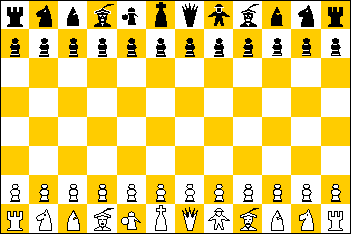Courier-Spiel
John Gollon, well known by chess variant enthousiasts for his book on chess variants, now unfortunately out of print, was working on a second book on chess variants. Also unfortunately, this second book was never published. Gollon has sent some materials from a draft of the book to Eric Greenwood (in 1976): the description given here is based on part of these writings by Gollon.
This is a more modern variant of Courier Chess. While Courier Chess was played in the 17th century near Ströbeck, the famous German chess village, Courier-Spiel was mentioned by H. G. Albers from Lüneburg in 1821 as being played in the same area; later the information of Albers was repeated by Verney in his book Chess Eccentricities.
Rules
The game is played on a checkered board with 8 rows and 12 columns. The left corners at each players side are dark colored. The opening setup is similar to Courier Chess:
 White:
White:
King f1; Queen g1; Rook a1, l1; Knight b1, k1; Bishop c1, j1; Courier d1,
i1; Councillor e1; Fool h1; Pawn a2, b2, c2, d2, e2, f2, g2, h2, i2, j2,
k2, l2.
Black:
King f8; Queen g8; Rook a8, l8; Knight b8, k8; Bishop c8, j8; Courier d8,
i8; Councillor e8; Fool h8; Pawn a7, b7, c7, d7, e7, f7, g7, h7, i7, j7,
k7, l7.
The king moves like a usual king, except for castling. When castling, the king moves to the square on the c-column or j-column; the rook goes to the nearby square jumping over the king (so to d1, i1, d8, or i8.) In addition to the restrictions on castling of normal chess, the king may also not castle when the rook moves over an attacked square or when the rook is attacked. So, for instance, when white wants to castle with his rook on a1, then neither king nor the rook on a1 may have moved, and none of the squares a1, b1, c1, d1, e1, and f1 may be under attack by an enemy piece when castling.
The queen, rook, and knight move as in orthodox chess. The courier moves like a bishop from orthodox chess. The fool (or schleich) moves one square in an arbitrary direction (i.e., as a king, but without being hindered by check). The councillor has the combined moves of a knight and king (but again, without being hindered by check).
The bishop moves one or two squares diagonally. When the bishop moves two squares diagonally, it may jump over an occupied square. (This is similar to the elephant from Shatranj, but with the additional possibility to move one square diagonally.)
The pawn moves and takes like a pawn from modern chess (including the possibility to make a double step at its first movement and en passant capture). After a pawn reaches the last row, it must stay there immobile for two moves, only at the third turn after the movement of the pawn it may move as the piece it is promoted to. So, if white moves a pawn to the last row, then first black moves, then white, then black, then white again, then black again, and then white may move with the pawn as a promoted piece. There are a few rules here that are unclear: can the pawn be captured while it is waiting to be promoted? Gollon favors an immunity for capture here, and such a rule seems quite plausible and reasonable. When must the owning player decide to which kind of piece the pawn promotes to? Gollon does not address this issue - I would guess that such promotion is made at the third move, i.e., after the waiting period. It is likely that pawns could only promote to pieces that were lost by the owning player and no other pieces. Gollon adds the following clarification: When no piece is available to be promoted to, the pawn stays immobile until such a piece becomes available. While immobile, the pawn cannot be captured. When a piece becomes available, the pawn promotes instantly.
Comments
An interesting game with roots going back far in history.
Links
See also:Written by Hans Bodlaender, based upon material written by John Gollon, sent to Eric Greenwood in 1976, and sent to me by Eric in 1997.
WWW page created: July 7, 1997. Last modified: July 11, 1997.
